Crawling Back: Amazing Spider-Man #9 Review (The Sinister Six, Part 4)
A packed, well-paced issue introduces us to yet another classic criminal in Spidey's rogues gallery
—by Nathan on June 19, 2024—
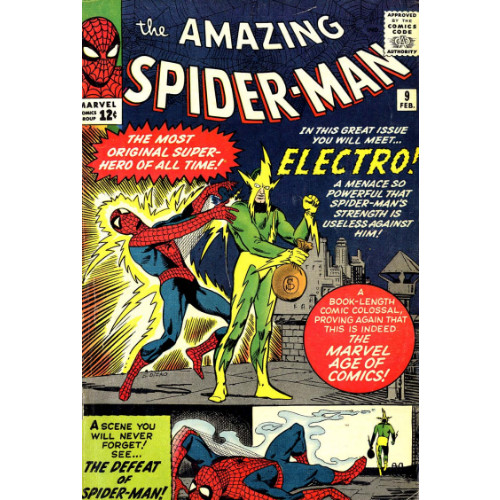
In my recent examination of the first appearances of the supervillains who composed the original Sinister Six, I've analyzed the debut of the team's brightest member...mentally. Today, we're looking at the debut of the team's brightest member, physically. Max Dillon, the human lightning bolt known as Electro.
Along with villains such as the Sandman, the Vulture, and the Green Goblin, Electro has been a mainstay Spidey adversary over the last 60 years, appearing in several notable narratives. He battled Spidey when the hero was racked with guilt over trouncing the Sin-Eater, became a "social justice warrior" combating Wall Street in the name of regular New Yorkers (and had a fight with Spidey where he took down the Daily Bugle!), and inadvertently formed the New Avengers (including our very own Web-Head) after causing a breakout at the Raft. One of my favorite fights between the spider and the spark plug comes courtesy of Mark Miller in Spidey's Marvel Knights series (which I will absolutely review at a much, much later date), where the villain managed to hospitalize our hero after a particularly brutal bout of flickering fisticuffs.
In conclusion: Electro's a pretty dangerous dude.
We all know the dangers of electricity. Maybe a small shock from a friend who rubbed their socks along the carpet is nothing compared to a lightning bolt, but it still stings. A little jolt right through you. And, yeah, we use it to run our houses and all kinds of appliances and even incorporate it into life-saving apparatuses, but it's still a force of energy we've merely bowed to our whims. Imagine if it stopped bowing. Picture a guy with all the power of a lightning storm who isn't on our side. He's like Thor but evil. But what else are we to expect from…
"The Man Called Electro"
Writer: Stan Lee
Penciler: Steve Ditko
Inker: Steve Ditko
Colorist: Stan Goldberg
Letterer: Artie Simek
Issue: Amazing Spider-Man #9
Issue Publication Date: February 1964
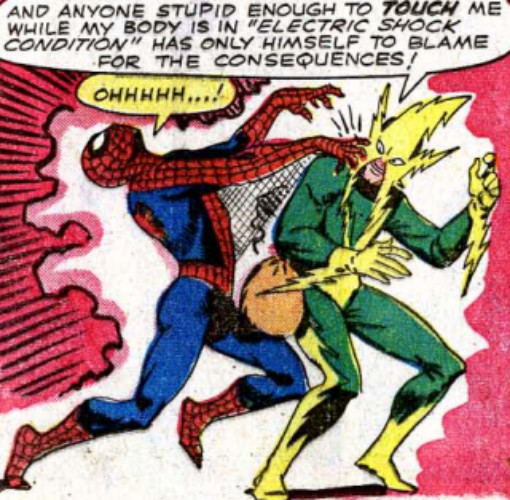
This issue hardly needs a review, not when the opening splash page basically tells you what will happen: readers are prepared from the start for "a really fascinating super-villain" starring in a story "chock-full of human interest drama." And if that's not enough for you (or if you've already forgotten the guy this book is named after), you learn this issue "shows Spider-Man, with all his human problems and frailties, greater than you've ever seen him before!’ And if that’s not enough to knock your socks off, I don't think a bolt from Electro can help.
Of course, we're left with these closing words: "But don't take our word for it–after all, we're Spidey’s best boosters! See what you think…” And the reader is left to turn the page, encouraged by Lee's passionate praise but offered the opportunity to form their own opinion. Thanks, Stan!
If you’re not won over by Lee’s carnival barker style of encouragement, maybe Steve Ditko’s art will reel you in. I don't comment often on splash pages, but this one is special. The image outlines all you really need to know: Peter Parker, plagued by problems. On his left, an ailing aunt, pushy publisher, and fickle friends, with a slimmer of hope from his beau Betty Brant. On his left, that same pushy, pernicious publisher, a disdained damsel, a puzzled public, and grief-giving gunmen. And hovering over it all, our issue's main antagonist, bolts sent ablazin'. My only wish is that the bolt was drawn to split Peter's persona from his Spidey self, but that's a minor criticism.

Amazingly, despite Lee's penchant for preaching, the issue largely lives up to the promise. We get the conflicts promised by his words and Ditko's image–Peter runs afoul of J Jonah Jameson, he bothers Betty Brant, he worries over his doting Aunt May, especially when she's admitted to the hospital for an operation which will cost the Parkers a hefty chunk-of-change. Spidey deals with a shocking new foe, a public swayed by Jonah's lies, and a bunch of criminals (though he deals less with gunsels and more with escaped prisoners). A whole mess of messes is packed into this issue, and though I'm often wary about how much plot some of these writers attempt to inject into a twenty-two page narrative, Lee and Ditko maintain a fairly decent pace throughout.
Guided by Ditko's scene setting, the issue marvelously switches between conflicts–we get a bit of Peter at the hospital, before he heads to the Bugle, before he swings off as Spider-Man. None of this is new by modern standards–how many times has Spidey dipped out of a fight because May's health took a downturn? How many times has she needed new medicines, hospital visits, life-saving surgeries? But I can see where, as this was only the ninth ASM issue, fans were less accustomed to Peter's typical struggles. And having all the conflicts compound one another just adds a heightened degree of uncertainty to the young man's life. If it weren’t for May's hospitalization, Peter wouldn't brush off his friends at school. If it weren't for May’s surgery, Peter wouldn't encounter Electro at the specific time he does, hoping to bring the costumed crook in for much-needed moolah.
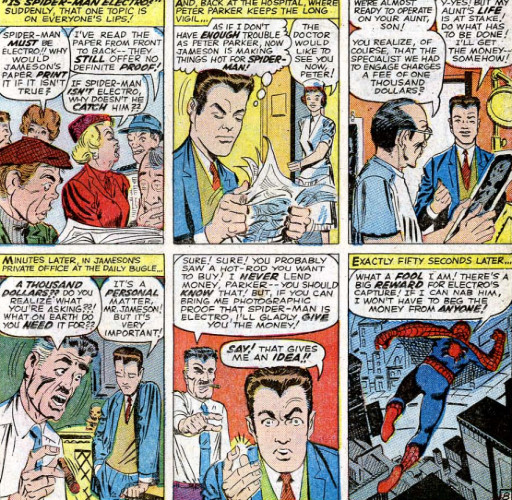
The JJJ dilemma forms a fun subplot which is woven into the larger issue, and though some argument could be made that it wraps up fairly conveniently for our protagonist, it does allow JJJ some decent "screen time" and forces the lovable louse of a boss to eat his own words by the end…largely. There's a slight sense that Peter, who makes quite the moral failing early in the issue, fixes a potential problem before we're allowed to see the ramifications. It could just be the era Lee and Ditko created this story in and the fact this was primarily aimed for younger audiences; without spoiling much, I'll note Peter has a lapse in judgment similar to one he would make years later, with much more disastrous consequences in that latter story. Here, the development is tidied up by the end so all ends well for the assembled parties, and we're given no more philosophical thought than how to charm your way out of possible legal trouble…I guess?
Uniquely, there's a sense of self-awareness floating through these pages which should encourage readers or at least make them aware that Lee himself understands the thematic elements he's tying into these early issues. Man-on-the-street scenes see a populace divided over Spider-Man, with some folks taking Jameson's words at face value while others wonder about the veracity of his increasingly outlandish claims. Peter, after swinging through a storm, ponders his mounting troubles as he wrings out his costume: "With my luck, I'll probably end up in bed with a cold!" he grouses. Even Flash Thompson, for a single panel, recognizes he's been kind of a jerk to Peter before switching back to bitterness in the very next panel. I appreciate moments such as these; they keep Lee's writing, which often feels formulaic and verbose, from becoming too canned and repetitive. Perhaps that's some of Ditko's storytelling prowess in there too, structuring scenes intentionally to allow moments of growth and change so we're not always slipping back into the same old exchanges between Peter and Flash or even Peter and Betty Brant.
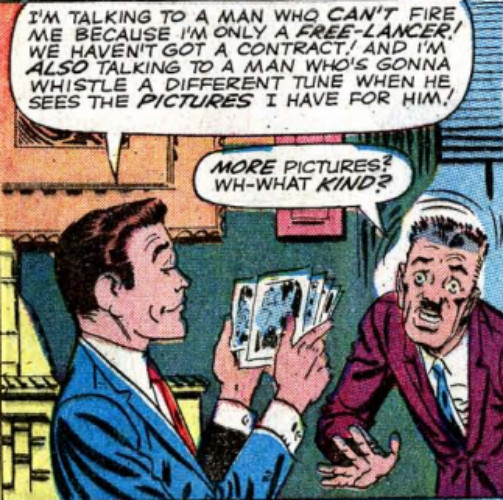
As a note, I'll admit that it took me a while to recognize some of these "patterns" Lee introduces, specifically through his dialogue, as blindspots rather than strengths. Peter's always comparing himself to other heroes ("Boy, I bet the Human Torch/Thor/Captain America doesn’t have days like this!"), and Aunt May's always sick with some illness. When I was younger, I think I saw these as essential elements which strung issues together, forming thematic tethers that kept our heroes grounded and personable. And I think, in some cases, it does. Peter's been dogged by the "Parker Luck" since his first appearance and that probably won't change–it's part of his radioactive DNA. But to lean into that by grumbling about his costumed compatriots gets stale after a while, a running gag which has lost its appeal.
Okay, off the soapbox.

Lee and Ditko somehow find space to also include backstory for Spidey electric enemy–Max Dillon, former lineman who got zapped by lightning after saving a coworker in danger on a power line. Which sounds nice, right? Maybe we should feel bad for Max's condition. Sure, maybe. But know he only agrees to save his coworker after being promised a bonus (which we're never told whether he actually receives) and immediately turns to crime after discovering his powers. Max is selfish, plain and simple. He falls into the "I have power and will use it to acquire wealth" category where guys like the Vulture and Sandman exist. His mind hasn’t been fractured like Doctor Octopus, who also received his powers after an accident. And he doesn't have a long-running scheme in mind like the Green Goblin. He's just a jerk.
Artistically, Ditko is allowed some license to toy with Electro's power set, meaning that while the villain's motivations may be somewhat generic, the art lacks no luster. Electro doesn't just hurl lightning bolts at people. He unlocks a safe with an electronic lock, turns power chords into electric whips, and takes out a security alarm. Later stories would beef up his powers and make him into a more serious threat…not that he isn't dangerous here, but Lee and Ditko seem limited by how lethal Electro can be. Even when fighting the villain, Spidey merely alludes to the danger Electro presents, keeping their battle more suitable for younger audiences. No need to see a security guard flash fried or a plane's navigational instruments go haywire. And Spidey, as he does elsewhere, relies on his brain to battle this bruiser, getting in a solid punch or two but ultimately learning from an initial defeat to even the odds against Electro. As he says, "Anyone with the knowledge of science" can clue into how to defeat an enemy powered by electricity. There's your lesson for the day, kids. Don't quit school.
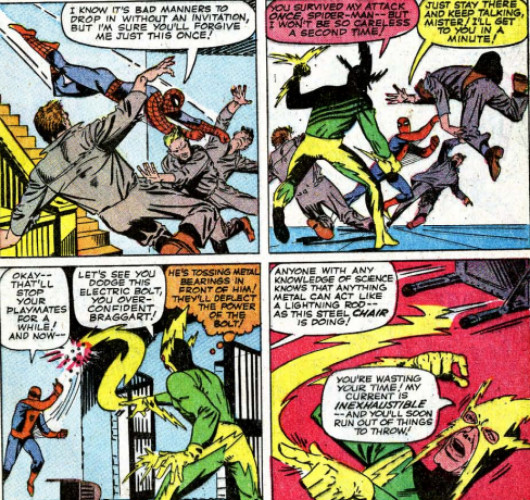
We get a surprisingly well-rounded issue from Lee and Ditko here. Though there's some interaction between Peter and Betty, it's clear of the forced emotional conflict of later issues–heck, Lee uncharacteristically resolves some minor tension that develops right at the issue's end, refraining from leaving his characters wallowing in uncertainty, which is a nice change of pace. We get a public who isn't 100% anti-Spider-Man. Yeah, the mainstays remain mainstays–Jonah's a jerk, Aunt May is relieved of yet another health crisis–but there are pieces here which make the issue a bit more unique. If a complaint can be found, it's in Peter Parker's brief brush with dishonesty and the charm he uses to sweep the whole bit aside. For an issue where the main villain is dangerously charged, it's our hero's mild-mannered alter ego who ends up providing the biggest shock.